Onkyo TX-NR686 Review
The Onkyo TX-NR686 is an AV Receiver (9) with 7.2 channels (10), from Onkyo (11). It makes fully equipped home theater affordable, because of its price (4). Even a comprehensive home cinema system (6) can find all the necessary connections including support for current standards (7) on the well-equipped hi-fi receiver (3). The mid-range device is also easy to navigate on the Internet (2), can even be operated using an app using Google’s voice control and has mastered some network functions (1). It is easy to install safely (8) for experienced users of receivers and also for beginners (5).
A few manageable weaknesses only come to light when we look at the details, and we will be going through them.
With the Onkyo TX-NR686, Onkyo is introducing its 7.2-channel network AV receiver. As the first in its series, the mid-range AV receiver should score THX certification and support for the Google Assistant. The loop through of 4K HDR in HDR10, HLG, and Dolby Vision formats are supported and Amazon Music is now on board.
Thanks to very effective high-current amplifiers, implemented in Dynamic Audio Amplification technology, using large transistors in the final stages, the device has met stringent technical conditions and has obtained the THX Certified Select certificate.
This means that in a room with a volume of up to about 56 m3, with a viewer distance from the screen of 3-3.6 m, the sound effect obtained will be very similar to what can be obtained in a professional cinema certified by THX Ltd. – in a word, a lot is happening.
The company managed to build an extremely versatile and powerful device, providing a naturalistic experience carried by 3D sound reproduction (Dolby Atmos and DTS: X), great freedom of wireless connections, and cooperation with the highest quality 4K image with HDR10, Dolby Vision or HGL. This is the receiver that has a 100% chance to meet the price and quality expectations of interested customers.
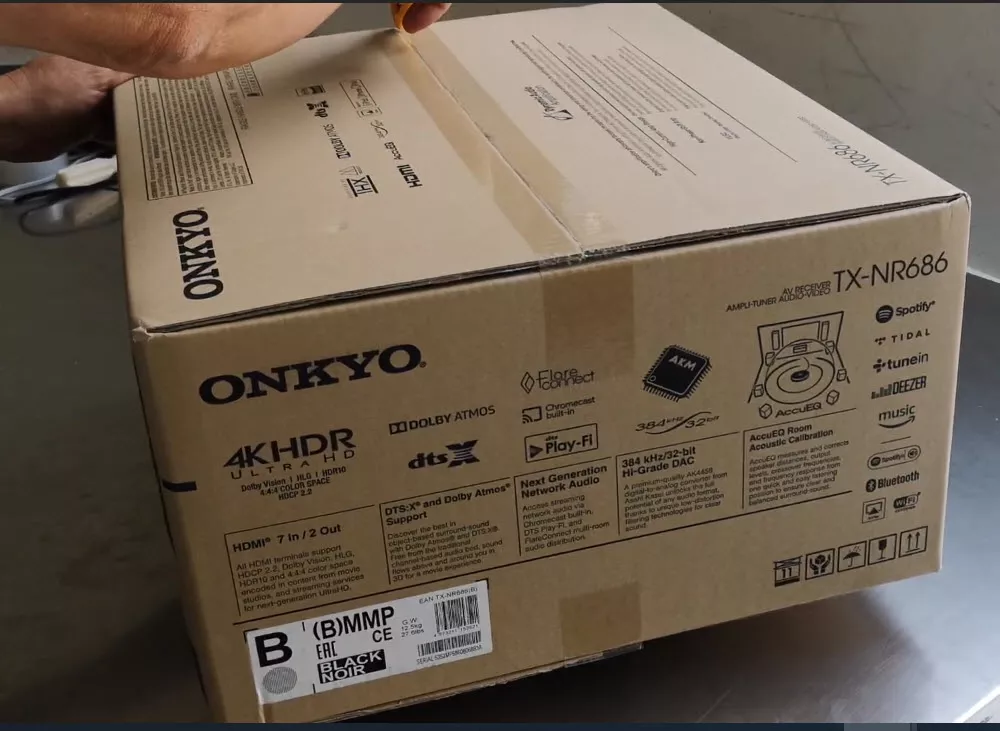
Onkyo TX-NR686 is a receiver that is to meet the quality expectations of all customers looking for a versatile device, but available at a reasonable price. Thanks to very effective high-current amplifiers implemented in Dynamic Audio Amplification technology, using large transistors in the final stages, the device has met stringent technical conditions and has been awarded the THX Certified Select certificate, that we will describe more later on.
The Onkyo TX-NR686 is ideal for small to medium-sized rooms and thanks to its intuitive user guidance, even beginners can easily set up their own home cinema.
Pros And Cons Of The Onkyo TX-NR686
Pros
- 7.2 or 5.2.2 AV receiver of the top class with 165 watts output power per channel.
- Suitable for home cinema sets such as Ultima, Consono, Columa, LT 4, Varion, Cubycon, System 4
- Supports THX, Dolby True HD, Dolby Atmos, DTS: X, DTS-HD Master Audio, and much more.
- THX certified.
- Music-Streaming with Bluetooth, AirPlay, Amazon Music, TuneIn, Deezer, Spotify, Chromecast built-in, TIDAL, DTS Play-Fi
- Highly expressive and dynamic sound with perfect bass control. Easy to use with a lot of amenities
- Very well equipped with all kinds of multiroom functions
- HDMI with support for 4K / 60 Hz, HDCP 2.2, 3D Ready
- HDMI inputs: 7, HDMI outputs 2
Cons
- The design could be sleeker. It is too big. Not an appealing design.
- App and streaming options are more difficult to implement than with competitors.
- For some more money, you have the superior Denon AVR-X2700H
Overall: Onkyo TX-NR686 will certainly satisfy the demanding home cinema users – it is a well-equipped multi-channel unit with considerable power and equipment that even the most advanced high-end receivers would not be ashamed of.
Every year the receiver manufacturers bring new models onto the market and it is not always easy to present innovative and / or useful things to customers. In the case of the Onkyo TX-NR686, there are some useful improvements compared to the predecessor TX-NR676E.
This 7.2-channel network AV receiver from Onkyo is rich in pioneering equipment and strong in sound. As the first in its series, the Onkyo TX-NR686 scores with THX certification and support for Google Assistant. The streaming option via Amazon Music is also new and extends the already wide range of integrated music services from its predecessors.
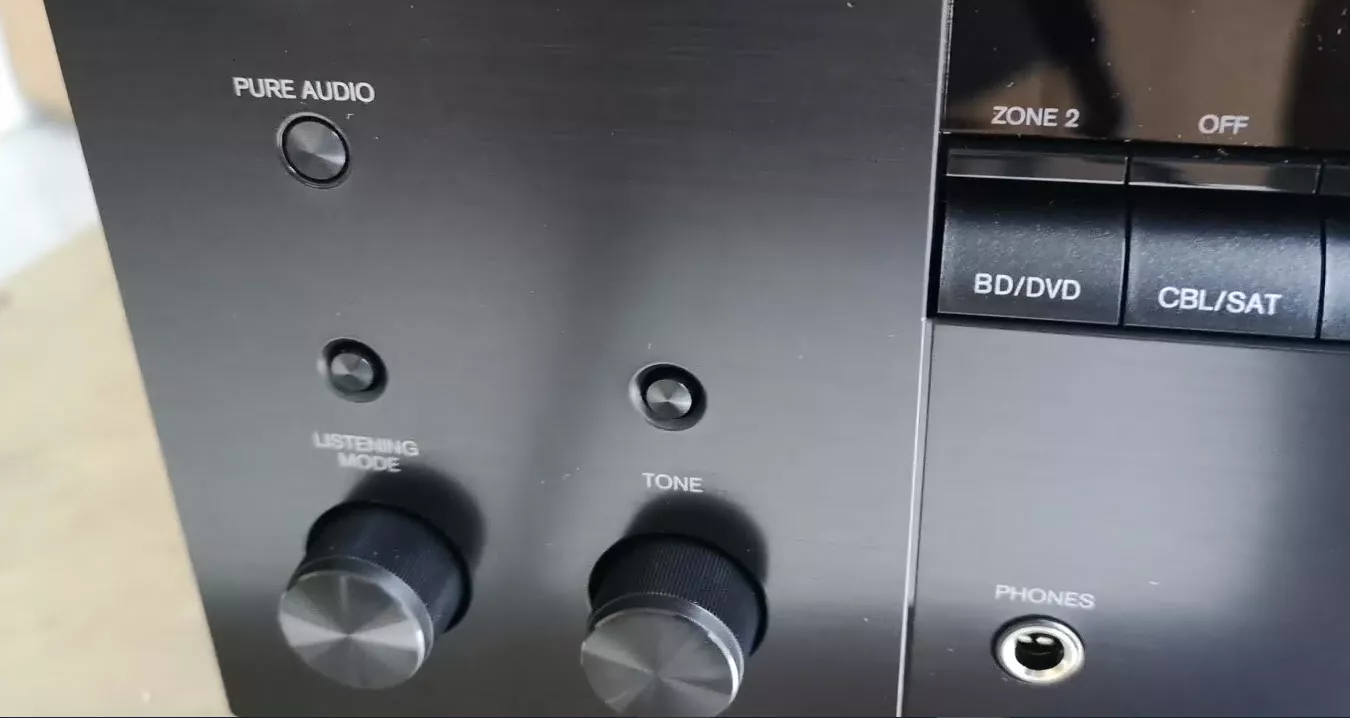
Main Features
It is called “7.2 channels” because it has seven connections for loudspeakers and two more for subwoofers. This should meet almost all requirements in the domestic sector. The built-in entrances leave nothing to be desired. Seven HDMI inputs, one of which is positioned at the front, and two associated outputs support all video standards up to Dolby Vision. So images from almost every source are recognized and forwarded, with the exception of HDR10+. Nothing else is missing either.
On the contrary, there is even a phono input for the turntable. The network can be accessed by cable or wirelessly. The two WLAN antennas should be able to achieve good reception. Streaming services and music from your own network can be played in this way.
In addition, other devices can be controlled with FlareConnect, a development by Pioneer and Onkyo, to play music in other rooms. Because Chromecast and Play-Fi are also supported, numerous devices are likely to be compatible.
Both the display with the limited display options and the USB port are somewhat simple. The fact that digital radio reception is not possible is not a problem with the many options. But to round it off it would have been nice.
The Onkyo TX-NR686 is THX Select certified and offers dynamic high current audio amplification. Of course, there are decoders for DTS: X and Dolby Atmos, including the upmixers Dolby Surround and DTS Neural: X. the upmixing is platform-independent.
With the help of the upmixer, you can also have conventional audio tracks, for example in 5.1, extrapolated to 5.1.2. In addition to the Onkyo-typical dynamic audio amplification, the Onkyo TX-NR686 is also the first model in a TX-NR6x6 series to be adorned with a THX Select certificate. And thus guarantees authentic cinema sound even at higher volumes.
Cinema sound at home: with THX Certified Select
New to an Onkyo device of the 6 series is the THX Select certification, which is not only rare in the entry-level class.
The Onkyo TX-NR686 is structurally advanced enough to undergo stringent tests, thanks to which it was awarded the THX Certified Select certificate – this means that the Onkyo TX-NR686 model is able to achieve sound effects that meet the standards of professional cinema certified by THX Ltd.
Onkyo has been working for years on adapting the devices designed in the Japanese company to the very strict standards imposed by THX Ltd., and if it became the norm that structures from the higher price level met these standards, it was not so obvious in the case of cheaper devices.
The Onkyo TX-NR686 proved that also less expensive devices from this manufacturer meet the highest standards in terms of sound, which is good news for fans of this Onkyo brand. Now, for relatively little money, they can become owners of a great receiver certified by THX Ltd.
In addition to the Onkyo-typical dynamic audio amplification (including the ability to control 4-ohm loudspeakers), the Onkyo TX-NR686 is also the first model of a TX-NR6x6 series to be adorned with a THX Select certificate – and thus guaranteed authentic cinema sound at higher volumes.
4K HDR, BT.2020, 4K / 60 Hz and HDCP 2.2 are no unknown numbers for the Onkyo TX-NR686: Six rear HDMI inputs support the looping through of 4K HDR in HDR10, HLG, and Dolby Vision formats – taking into account the BT.2020 specifications, playback in 4K / 60 Hz and the HDCP 2.2 standard for premium content. Video cameras or consoles can be connected via the front HDMI connection, while the rear sub out is ideal for connecting a projector.
Thanks to the THX standard, the 650-dollars AV receiver meets the performance requirements according to the THX standard for small to medium-sized rooms. There are also the THX sound circuits “Cinema”, “Music” and “Game”. The streaming section has also been upgraded: Google’s Chromecast now includes the Google Assistant for voice-controlled music streaming.
However, this requires a compatible speaker that sends the voice commands to Google – such as Onkyo’s Smart Speaker G3. The engineers also integrated the Amazon Music service into Onkyo’s controller app; Spotify, Tidal, and Deezer are still available.

Equipment and Features
The appearance of the receiver, available in black or silver, has hardly changed compared to the previous TX-NR676, but the smoothly running volume wheel has been redesigned; it is now a little lower and is, therefore, more tangible. On the back everything stayed the same: There you will find 2 HDMI outputs and 6 HDMI inputs according to the 2.0 standard; the HDMI interface at the front also accepts 4K or HDCP 2.2 signals. A phono board and 3 digital S / PDIF inputs are added to 6 analog stereo RCA inputs.
The structural layout also remained unchanged: Since the Onkyo TX-NR686 only has 7 power amplifiers, it can be used to implement a maximum of 7.2 or 5.2.2 layouts with 2 ceiling boxes for 3D sound. Due to the lack of pre-outs, the multi-channel sound is limited to 7 channels plus 2 subwoofers; 9-channel sound and more is only available at Onkyo from the larger RZ series. Free power amplifiers can also be used for bi-amping the main speakers or for active sound reinforcement in a second room; alternatively, the pre-outs provide audio signals for a second listening zone.
4K HDR, BT.2020, 4K / 60 Hz and HDCP 2.2 are no unknown numbers for the Onkyo TX-NR686: Six rear HDMI inputs support looping through 4K HDR in HDR10, HLG and Dolby Vision formats. Video cameras or consoles can be connected via the front HDMI connection. While the rear sub out is ideal for connecting a projector.
Six HDMI connections of current specifications can be found on the back. 4K / 60p, BT.2020, and the HDR standards HDR10, HLG and Dolby Vision are supported. Another HDMI input is located at the front.
As has become common practice with Onkyo and Pioneer, the Onkyo TX-NR686 also presents itself as extremely flexible in terms of multimedia. Google Chromecast, with Google Assistant capability in 2018, is installed, as well as DTS Play-Fi.
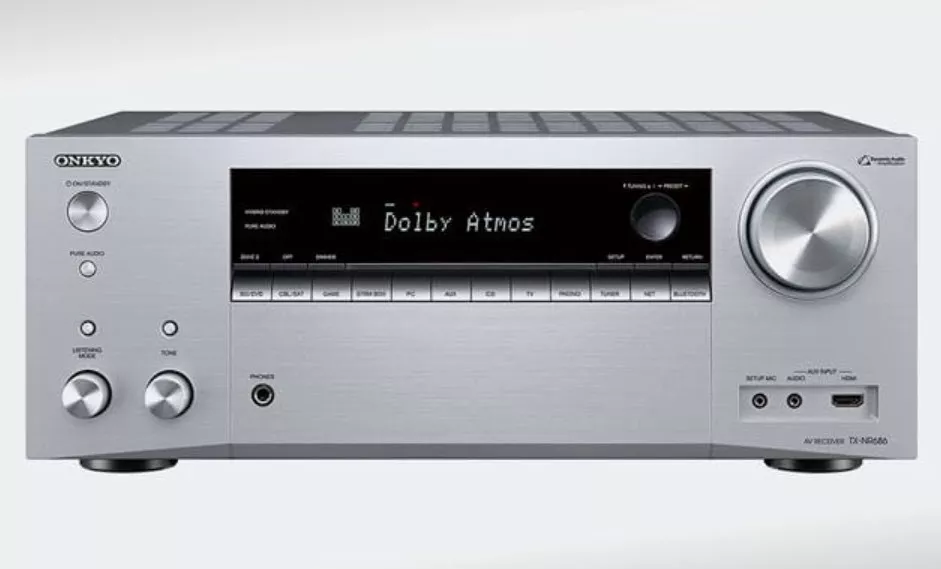
I have been testing four Onkyo receivers, cunting this one, so I easily noticed that compared to older models, the design of the power supply system and the end stages has changed somewhat. In some areas, this has been improved to adapt the Onkyo TX-NR686 to the appropriate level of performance, which Japanese engineers have been working on for some time, especially for cheaper receivers.
It was primarily about providing a larger current buffer for the end stages to adapt to support even more demanding speaker sets. The manufacturer announced, therefore, that after entering the market of this particular model of the receiver, its users will not have any problems with driving even the most demanding speaker units,
I particularly liked the bass, sometimes bulky, heavy and massive, but always well controlled
A more powerful transformer was used, as well as even higher quality capacitors produced in cooperation with Nippon Chemi-con (in this particular model two electrolytic 68V units with a capacity of 8200 microfarads each was used).
Improved rectifier bridges have also been used, which are characterized not only by increased reaction speed but also by higher current carrying capacity.
As a result, a power supply system was created that was able to meet the increased demand for the current of the final stages responsible for the amplification of the signal supplied from the preamplifiers section. These were separated, although they were applied to a common circuit board, so each section of the preamplifier is assigned to each channel separately.
Digital audio processing is supervised by the latest digital-to-analog converters supplied by the well-known and respected Asahi Kasei brand (these are AKM AK4458 384kHz / 32-bit units), the analog path has also been shortened, supporting not only signals delivered to the preamplifier section but also tracks for analog inputs located in the rear panel area. In general, the whole audio track is even more compact, which has improved the quality of signal distribution.
Of course, the Onkyo TX-NR686 also supports hi-res audio. DSD in 2.8 / 5.6 MHz, 192 kHz / 24-bit Flac, WAV, ALAC, AIFF and Dolby True HD are played.
Front And Back
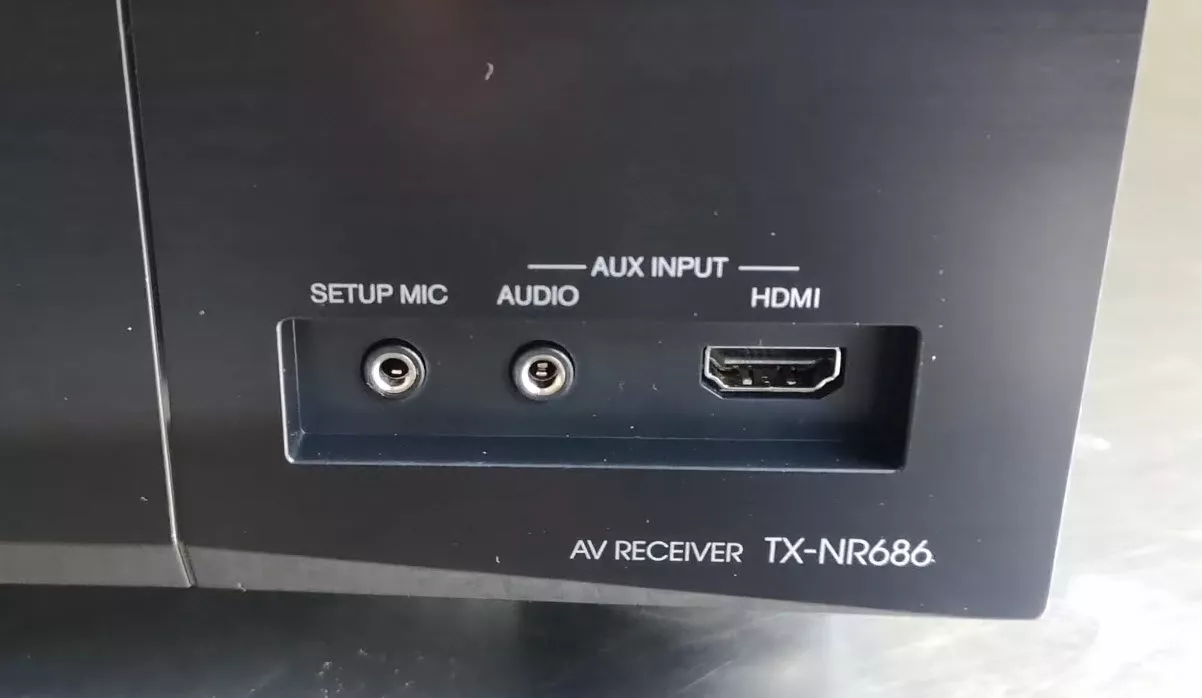
In the front, we already mentioned above that what we saw is a PHONES jack located under the main display while under the volume knob there is the testing microphone port, an analog 3.5mm stereo input port, and an HDMI port with HDCP 2.2 support for quick access.
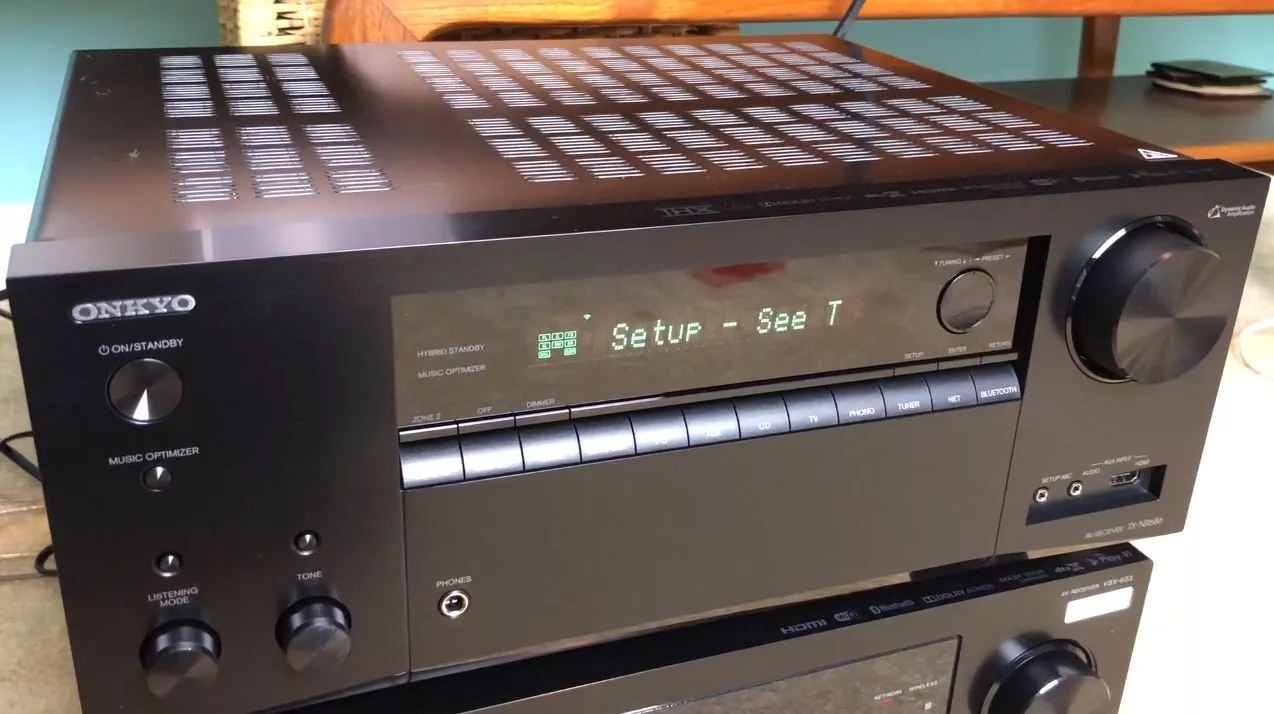
One thing that made us an impression is the inclusion of the analog input while at the same time omitting the frontal USB port. Most mid to high range AV receivers go for a USB at the front (go to some of our Denon reviews) but Onkyo instead decided to include a stereo input which may have some value for specific people but it left us scratching our heads for such a decision.
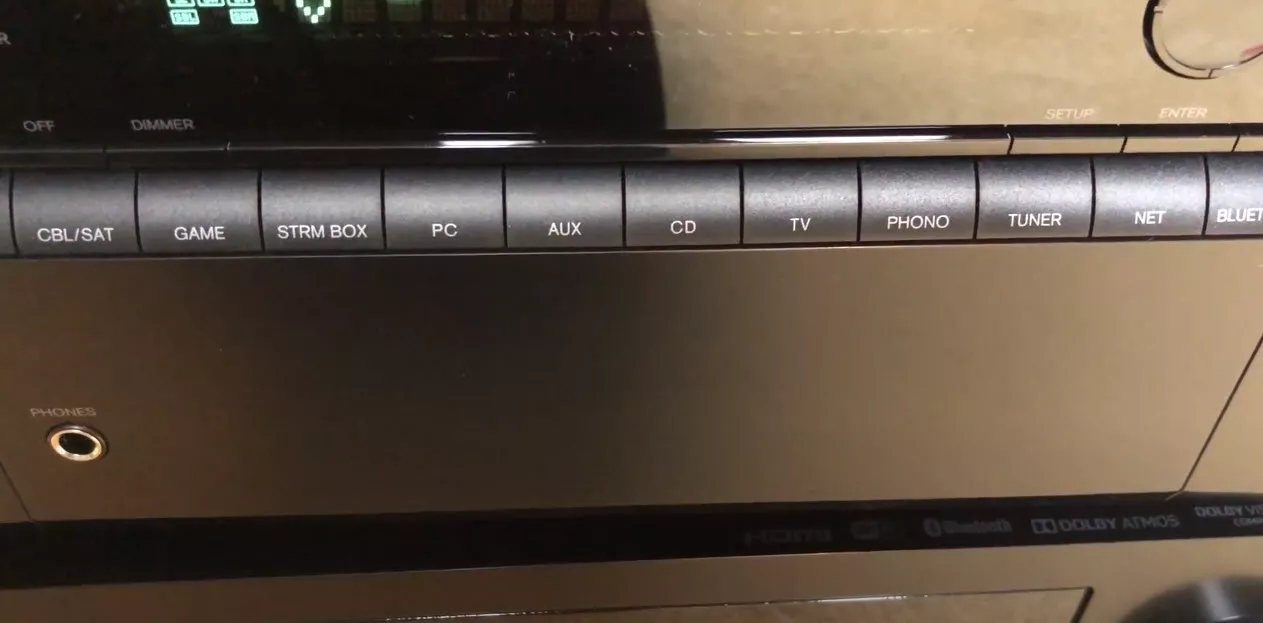
Let’s go in the back now to see what Onkyo has managed to fit there. The first thing we notice is the 6 HDMI inputs and 2 HDMI outputs. With the inclusion of the front HDMI port, we reach 7 which is more than adequate in order to connect all your devices in your home theater system. Also by including a second HDMI out gives you even more options.

All the HDMI ports support HDCP 2.2, 4K/60 Hz, all HDR protocols like HDR10, Dolby Vision, and HLG as well as the new object-oriented audio tracks like Dolby Atmos and DTS:X. We also get 7 speakers terminals with built-in amplification enough to create a 7.2 or a 5.2.2 audio setup if you want to take advantage of the overhead layer of the new formats.
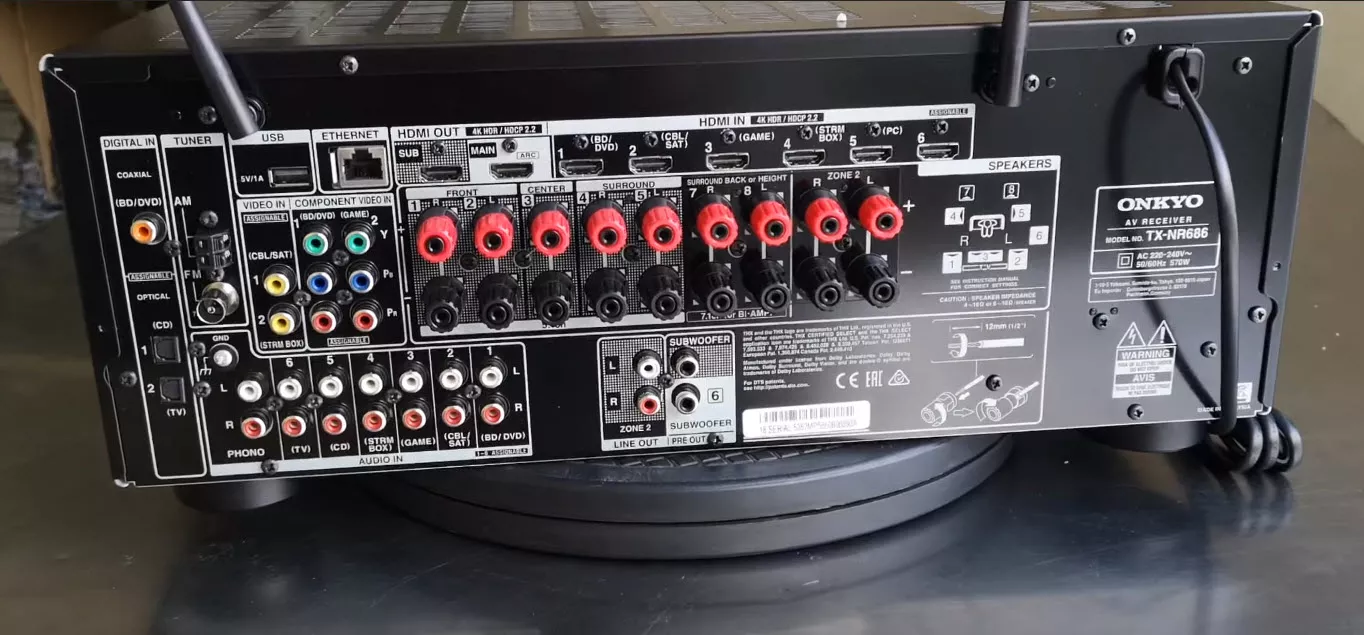
Onkyo has also included one coaxial and two optical audio inputs, a USB port (5V/1A) which is a bit strange to have one in the back as it is not practical at all, an Ethernet port for wired connection to the internet, tuner antenna ports, one zone 2 lines out and 2 sub outputs for creating a dual subwoofer setup and thus making the neighbors even more frustrated than before.
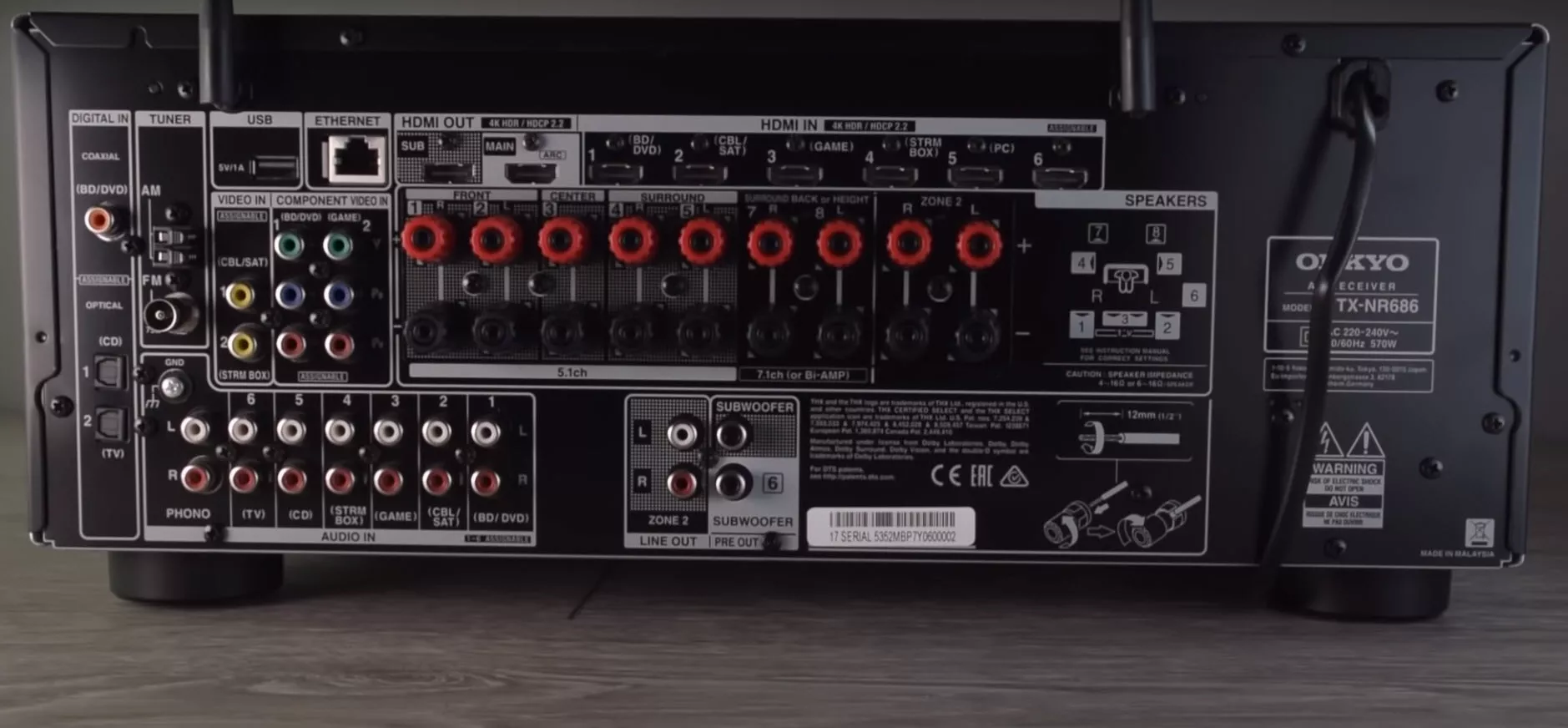
As for legacy connections, the Onkyo TX-NR686 comes with 2 composite video inputs and 2 component video inputs. There are also 6 analog stereo inputs and a phono stereo input.
Accessories And Configuration
AccuEQ-Microphone

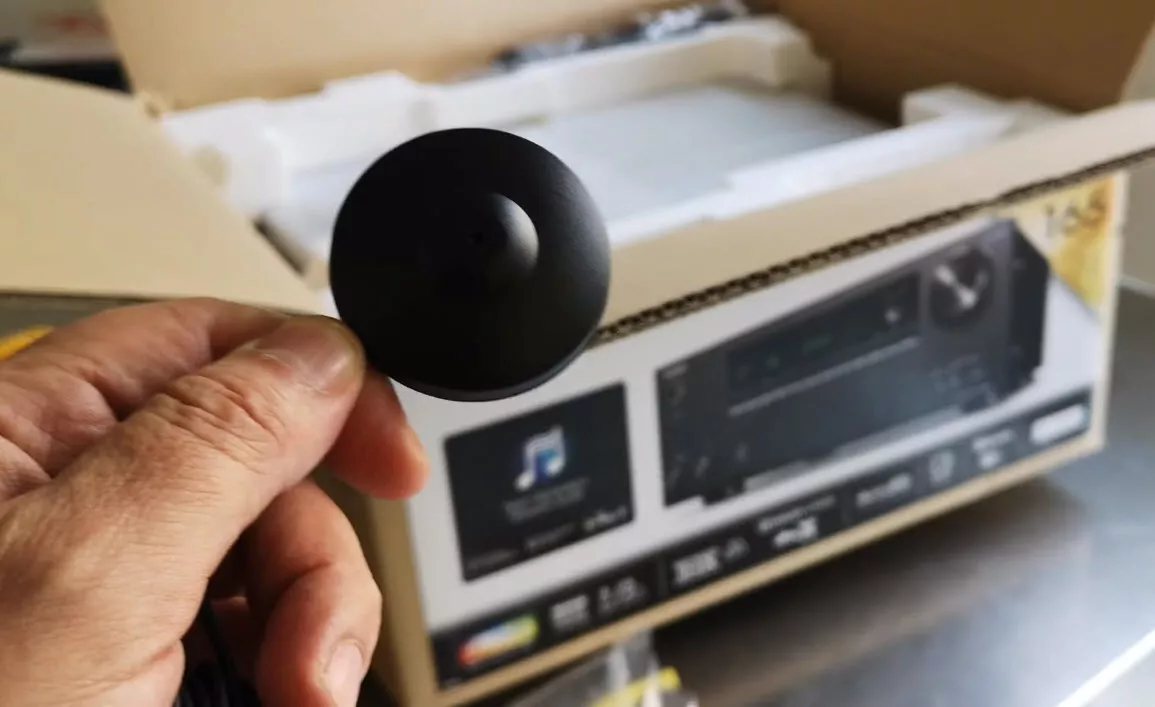
The Onkyo TX-NR686 comes with Onkyo’s own AccuEQ speaker measurement and room EQ system. It also has 384 kHz / 32-bit D / A converters from AKM (AK4458). In general, Onkyo strives for high-quality technology in the 600 to 700 dollars league.
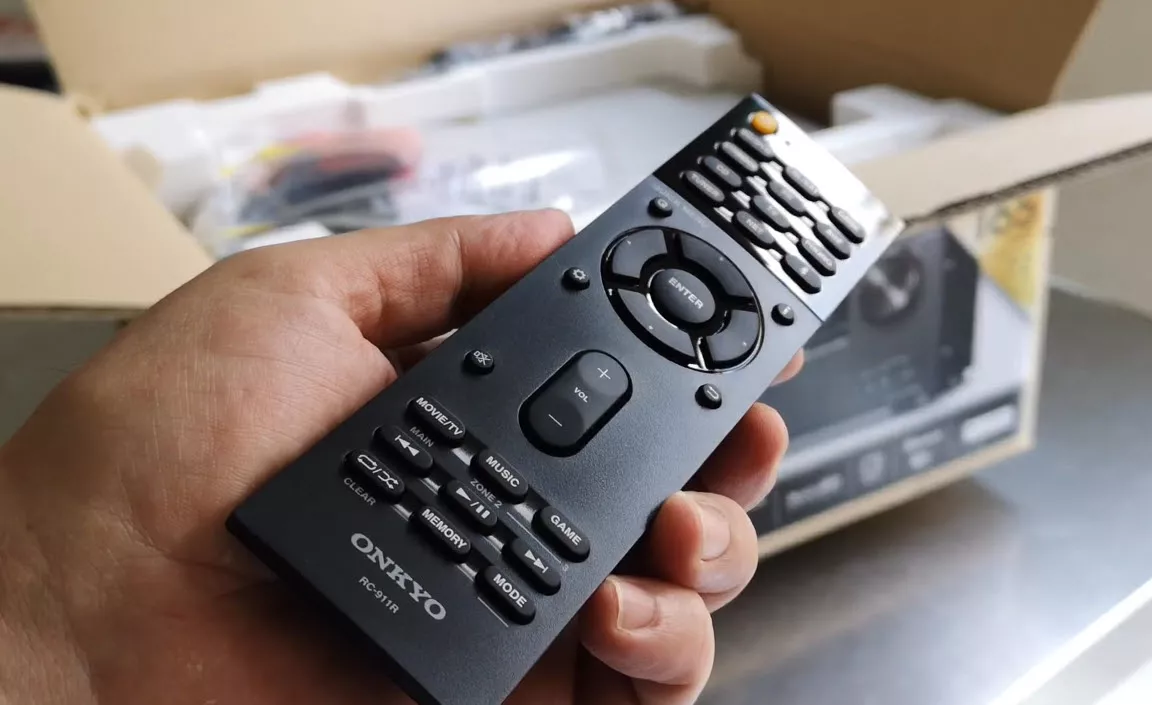
165 watts/channel sound very good, but to be fair, you have to add that only one channel and not all seven channels are controlled with these measurements. Only a few companies, such as Arcam, also give the values when controlling all existing channels. Usually only stereo, 20 Hz to 20 kHz, or only one channel, 1 kHz, is measured.
The fact that the Onkyo TX-NR686 has to have a lot of power shows that the manufacturer cites dynamic audio amplification with the control of 4-ohm speakers as a feature. The high power supply capacity required for this is ensured by the special power supply unit with corresponding reserves. Of course, there is also the Vector Linear Shopping Circuitry (VLSC) to eliminate high-frequency noise on the front left and right channels. The amplifier circuit without phase shift for clear and detailed reproduction is also on board.
The box configuration allows the placement of the two height boxes as “Height” speakers at the front and rear, with “Top” positions at the front, center, and rear. Of course, Dolby-Enabled speakers (top boxes) are also supported. Onkyo relies on phase calibration using “Accu-Reflex” to ensure that it is emitted at the correct time. Unfortunately, the two pluggable subwoofers cannot be controlled separately; the same signal always sounds from both outputs.
Onkyo’s automatic measurement system “AccuEQ” is limited to just one measuring point and also only delivers an equalized EQ target curve, which can be applied to all speakers or omits the main speakers. The equalizer can also be activated parallel to AccuEQ, but it only applies to pairs of boxes. Of the 15 bands, 9 can be activated at the same time, the filters range from 25 to 16 kHz. There is scolding for the too-large distance and level steps of 3 centimeters or 1dB units; 1 centimeter or 0.5 decibels would be better. We have nothing to complain about in the crossover management, which provides cut-off frequencies between 40 and 200 Hertz for each pair of speakers, and between 80 and 120 Hertz on the subwoofer.
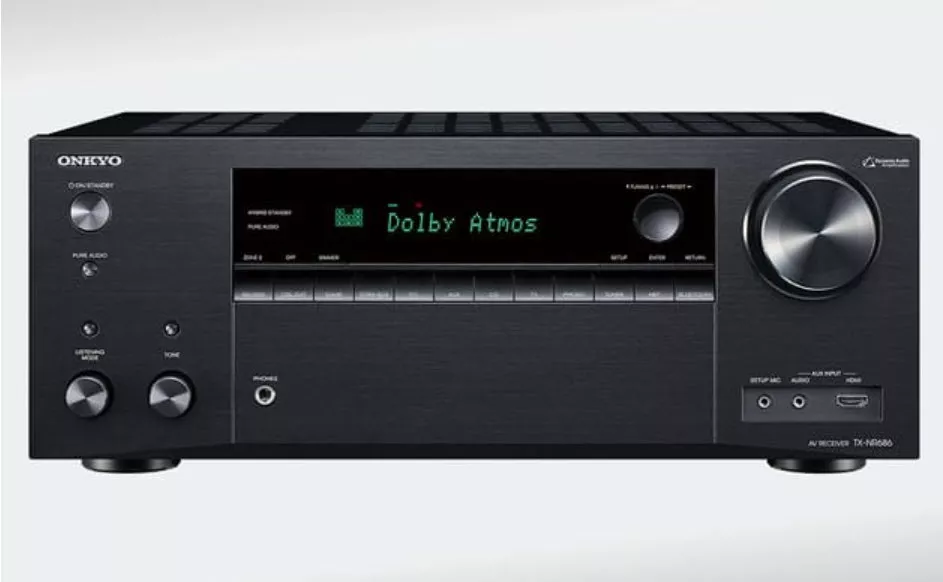
Dolby Atmos and DTS: X with upmixing
the Onkyo TX-NR686 supports both Dolby Atmos and DTS: X in 5.2.2 set-ups – but not only that: Upmixing technologies from DTS (DTS Neural: X) and Dolby (Dolby Surround) find spatial information in conventional multi-channel soundtracks and also prepare them for 3D audio playback. Popular film soundtracks in Dolby Digital 5.1, Dolby TrueHD, and DTS-HD Master Audio suddenly sound much more immersive – whether via Blu-ray or video streaming.
The decoders for Dolby Atmos and DTS: X are joined by their upmixers Dolby Surround and DTS Neural: X. Onkyo will also have to do without Auro 3D In contrast to older AV receivers in the house, the Onkyo TX-NR686 allows cross-format upmixing. In this way, DTS signals can be reproduced with Dolby decoders and vice versa. Native 3D sound is an exception. The three THX sound programs do not support height boxes and work with all sound signals except Dolby Atmos and DTS: X.
Video and multimedia
The video board of the Onkyo TX-NR686 processes 4K / 60p signals including HDCP2.2, HDR10, Dolby Vision, and HLG, and is therefore still up to date. Receivers with HDMI 2.1 will probably not be launched until next year. You have to do without a video scaler and video equalizer, which costs points. The device loops through video signals 1: 1. The manually adjustable lip-sync delay has a wide control range from -100 to +500 milliseconds.
Streaming On-Demand In The Onkyo TX-NR686
Streaming from a smartphone, laptop or PC is simple with the Onkyo TX-NR686. Thanks to the integrated Chromecast technology, users can control the playback of any music using their favorite Chromecast-enabled apps on iPhone, iPad, Android device, Mac, Chromebook, or Windows laptop.
With the Onkyo Controller App, streaming services and network-based audio can be managed through a single interface. The app enables Internet services to be searched and navigated, distributes the desired music across the entire home at the touch of a finger, and controls its playback.
If you have a speaker compatible with Google Assistant, you don’t even need your hands free. Then a simple call is enough to change the music program. Also practical: With the Onkyo Controller App1, streaming services and network-based audio can be managed via a single intuitive interface. The app enables Internet services to be searched and navigated, distributes the desired music across the entire home at the touch of a finger, and controls its playback.
Onkyo TX-NR686 has a whole range of wireless connectivity options and two wireless multiroom technologies: FlareConnect and DTS Play-Fi. You can enjoy music from any mobile source or PC using for connection: Chromecast, AirPlay or Bluetooth.
Using the Onkyo Controller application (Android, iOS) you have access to full device control (including the ZONE2 analog multi-room), and you can also use the following websites: Spotify, TIDAL, TuneIn, Amazon Music, Deezer.
The on-demand music and internet radio services integrated in the user interface of the Onkyo TX-NR686 recently include the aforementioned Amazon Music alongside Spotify2, TIDAL2, Deezer2, and TuneIn2. All network streaming and control functions, including those of AirPlay, work via 5 GHz / 2.4 GHz WLAN. This ensures their stability even in areas with an overloaded network. The possibilities for music streaming are further expanded via integrated Bluetooth wireless technology.
Flare Connect System
What about Fire Connect? The system, originally from Blackfire Research, was taken over by Pioneer Onkyo and is now called Flare Connect. AirPlay and Bluetooth complement the extensive range of equipment. Deezer, Tune In Internet-Radio, Spotify, Amazon Music, and Tidal are supported on streaming services.
Onkyo TX-NR686 offers a whole range of possibilities related to the wireless signal transmission for multiroom thanks to FlareConnect technology (after updating), as well as Play-Fi used for some time in almost all Onkyo receivers. The user can also use Bluetooth as well as AirPlay or Chromecast. In turn, thanks to the Onkyo Controller application available for Android and iOS, it is possible to control the receiver using portable devices, but also to use websites with internet music such as Tidal, Spotify, Amazon Music or Deezer.
In the rear panel area, there are all the necessary connectors that are sufficient to use all methods of video and audio transmission – there were also HDMI inputs in the latest specification, as well as a phono preamplifier and a wide range of analog stereo inputs on RCA connectors. Onkyo TX-NR686 is also based on independent outputs from the final stages for the second zone and the analog controlled outputs from the preamplifier. There were also optical and coaxial digital input, as well as two subwoofer outputs.
Audio Quality
We tested in track, selecting pieces of music and also movies. In the measurement, the Onkyo TX-NR686 was able to build on the values of its predecessor in most disciplines: 175 and 149 watts per channel for stereo (4/6 ohms) are excellent in this price range and the small receiver always delivered even with 7 simultaneously used power amplifiers still 82 or 69 watts (4/6 ohms).
Our test sample cracked in 5-channel operation at 4 ohms: Here, the power per channel decreased by around 20 watts compared to the previous year’s model. In contrast, 98 watts at 6 ohms corresponded to the 5-channel power of the TX-NR676E.
In the hearing test, however, this played practically no role. Here the Onkyo turned out to be no child of sadness, he played dynamically and powerfully, whereby rock music resounded particularly lively and with a high fun factor. Classical recordings, on the other hand, lacked a bit of suppleness, as 5.1 baroque music from an SACD revealed. The Onkyo TX-NR686 also did not resolve complex orchestral arrangements as audibly and extensively as the more expensive AV receiver can.
The measurement was quick and without complications, but we had to readjust the crossover frequencies and distances somewhat. With the AccuEQ active, the Atmos trailer next rotated in the player: In the “Amaze” clip, the “Powerful Bass” pressed extremely neat and contoured – and not as exaggerated as we are sometimes used to from Onkyo devices. The flying effects were cleanly located in the room, even if the sound field should have been a little larger.
Sometimes the Japanese device raised the synthesizer sounds in a perceptible way, but not as precise as it would be possible with four ceiling speakers. Likewise, the Onkyo impressed with its large, locatable effect, only with the bass we wanted a little more precision and depth.
Even with stereo music in Pure Direct mode, which bypasses all components that are not absolutely necessary for playback, the Onkyo was a lot of fun with its direct, powerful, and fine-resolution play.
Onkyo TX-NR686 provides dynamics on an impressive scale and also has excellent full-range sound control. The tested multi-channel unit captivates with its vigor and power disposition regardless of the volume at which it will work.
Onkyo did particularly well with a track recorded in DTS-HD Master Audio 5.1 (48kHz, 24-bit). It was played by Onkyo TX-NR686 with precision and control worthy of much more expensive multi-channel constructions. I particularly liked the bass, sometimes bulky, heavy, and massive, but always well controlled.
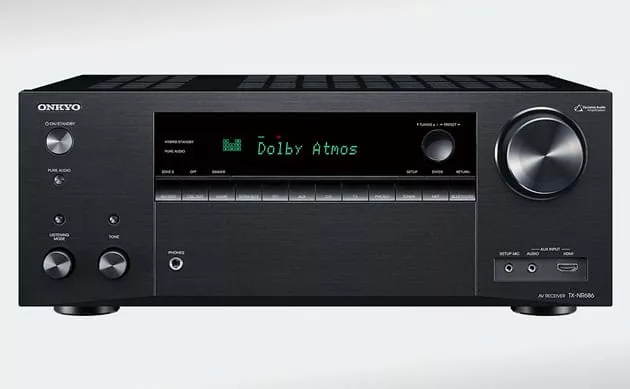
In turn, during film screenings Onkyo managed in a similar style, maintaining above all iron control over all sounds, especially those reproduced in the lowest tones – so I watched the latest part of Bond’s adventures with pleasure, because all the scenes I know requiring precision from a multi-channel receiver in reproducing the mass of sounds appearing at the same time, they turned out to be presented in detail and dynamics. I always use a James Bond movie for testing: many sounds appearing at the same time.
Onkyo, on the other hand, is not distinguished by some sonic finesse – the timbre is neutral, and the high tones are presented directly, without embellishment through gentle smoothing or slight warming. So if you like a direct, energetic, and above all balanced presentation, then Onkyo may appeal to you.
Onkyo TX-NR686 focuses on the same sound elements regardless of the type of music source. When I listened to music from the Tidal website – connection to a smartphone via Bluetooth – it turned out to sound just as good as when playing music in stereo from a CD player. Onkyo sounded very effective, but also naturally sounded when I played two-channel music in several 5.1 modes giving it volume and sound range.
Multiroom
Onkyo’s “Controller” app enables comfortable listening to music and multi-room applications. With FlareConnect, DTS Play-Fi, and Chromecast, the receiver offers many streaming technologies. In addition, the Onkyo contacts the music via AirPlay, Bluetooth, DLNA client and USB, the media player accepts hi-res files (including FLAC, WAV, AIFF, ALAC) with 192 kHz / 24 bit as well as DSD files up to 5.6 MHz. An AK4458 chip with 384 kHz / 32 bits from AKM is responsible for the D/A conversion.
While other multiroom receivers often only work within a closed system of individual manufacturers, Onkyo enables the wireless playback over any number of rooms with the support of various multiroom platforms such as the integrated Chromecast technology, DTS Play-Fi or FlareConnect. And across different components. The music program can be tailored to the respective ambiance or individual mood. The Onkyo Controller App for iOS and Android controls the multiroom playback of streaming services, internet radio, and network files as well as music from external CD players and turntables.
Impedance Analysis And Power Consumption Analysis In The Onkyo TX-NR686
Model Onkyo TX-NR686 is able to work with columns with a rated impedance of 4 Ω. Speaker sets characterized by such rated impedance in comparison with 8Ω constructions force the amplifiers to consume much more current and, above all, power. This is a kind of paradox because the speakers with lower impedance cause that in most amplifications their power doubles, but not every amplifier will be able to handle it.
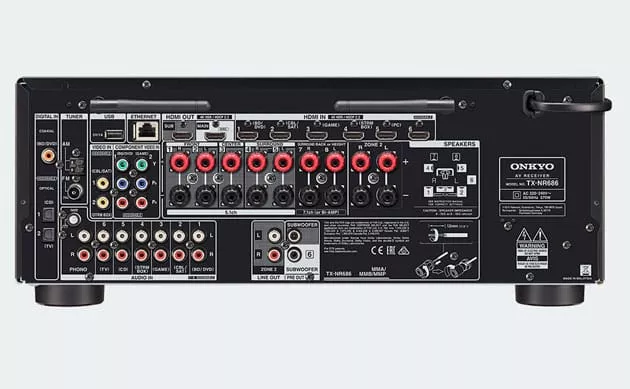
That is why a very important element of any amplification, especially multi-channel, is the power supply system, which is designed to provide a sufficient dose of current, even when the end stages work at very high volume levels.
In the Onkyo TX-NR686 model, the manufacturer focused its efforts on using a more efficient power transformer and providing the desired current storage, until obtaining the appropriate characteristics in terms of response to the demand for the current of the final stages at a given moment. Therefore, the rectifier system, current storage capacitors, as well as the circuit itself supplying power to the transistors were refined.
Conclusions: Is The Onkyo TX-NR686 Worth It?
The Onkyo TX-NR686 belongs to the mid-range multichannel receivers, but in terms of power output and equipment, it offers a lot. Thanks to continuous technological progress, currently produced multi-channel receivers have the potential at the level that was once reserved only for flagship designs.
So Onkyo introduced another multi-channel receiver with rich functionality. The Japanese company ensures that it managed to build an extremely versatile and powerful device, providing a natural experience carried by the reproduction of 3D sound, great freedom of wireless connections, and cooperation with the highest quality 4K image with HDR10, Dolby Vision and HGL.
The price of Onkyo TX-NR686 is attractive, especially when you consider its equipment and possibilities. Another thing is the sound quality, which can meet the criteria of even demanding fans of multi-channel sound. Onkyo can captivate with absolute sound control with a phenomenal impulse response with a powerful, but also disciplined bass. A nice bonus is also an efficient automatic calibration system, which less experienced users in the settings of the equipment will do well without taking too much time.
The latest models from the medium or budget price shelf are equipped just as well as top constructions. Naturally, the flagship devices of individual manufacturers have much greater possibilities in terms of power output or current efficiency, thanks to more complex power supply systems or higher power stages. However, as market realities have shown, even if someone is demanding in terms of sound, they should not necessarily cross out cheaper devices
When it comes to multimedia, multiroom and 4K video, Onkyo’s entry-level Onkyo TX-NR686 THX doesn’t have to make any compromises compared to more expensive models. The 7 amplifiers also impress with their powerful and dynamic sound. You will hardly find a better receiver for 650 dollars.
The Onkyo TX-NR686 combines first-class equipment with excellent sound – and at a very reasonable price. It is ideal for small to medium-sized rooms and thanks to its intuitive user guidance, even beginners can easily set up their own home cinema.
For a little over 600 dollars, you can get a device that can handle almost anything and can bring music to other rooms. Basically all formats that occur with music or video signals are mastered. The relatively open design through the combination of a total of three multiroom standards is an important argument. The fact that a few things are not perfectly resolved does not matter for this sum and considering the almost complete equipment.
When we care about having one universal device that is an entertainment center, so far nothing better than receivers have been invented. It so happens that Onkyo is launching a perfectly suitable for these purposes, modern but not overloaded 7.2 channel multi-channel receiver – model Onkyo TX-NR686.
Product Specifications For The Onkyo TX-NR686
To show how technically advanced modern receivers are, we show a handful of functions that you can, but fortunately, you don’t have to use – the daily use of the Onkyo TX-NR686 is not as complicated as it might seem at first glance.
The most important features of Onkyo TX-NR686:
PRODUCT Onkyo TX-NR686
TYPE Home cinema receiver
WEIGHT10 kg
DIMENSIONS (W × H × D) 435 × 173.5 × 379.5 mm
- THX Certified Select – cinema reference sound
- Decoder: Doly Atmos (5.2.2.) And DTS: X
- Output power: 165W / channel
- HDMI: 7x inputs (1 front), 2x outputs (main and sub) – 4K / 60 Hz, HDR10, HLG, Dolby Vision, BT.2020, HDCP 2.2 pass-through
- Amplifiers: Dynamic Audio Amplification – works with 4 speakers?
- D / A converters: AKM (AK4458) 384 kHz / 32-bit – and VLSC filter
- Chromecast built-in
- Cooperation with Google Assistant
- Dual-Band Wi-Fi, DTS Play-Fi, AirPlay, Amazon Music, Spotify, TIDAL, Deezer, TuneIn
- FlareConnect
Features that ensure modernity:
- HDMI – HDR10, HLG, Dolby Vision, BT.2020, 4K / 60 Hz, Pass-through and HDCP 2.2
- Dolby Atmos decoder (5.2.2.) And Dolby Surround – spatial playback of audio formats also DTS
- DTS: X and DTS: Neural: X decoder – spatial playback of audio formats also Dolby
- AccuEQ – system calibration adapted to room acoustics
- AccuReflex – front phase equalization / additional speakers (Dolby Atmos)
- Onkyo Controller – an application for portable devices for operating devices and multiroom ensuring intuitive use.
- Stable dual-band Wi-Fi 5 GHz / 2.4 GHz
- Chromecast built-in – wireless audio streaming technology working with Google Assistant
- DTS Play-Fi – sends music from the receiver to wireless speakers. Multiroom controlled from the Onkyo Music Control App
- AirPlay – streaming from iTunes, iPad, iPhone and iPod
- Hi-Res Audio – DSD: 5.6MHz / 2.8 MHz, 192 kHz / 24-bit FLAC, WAV (RIFF), AIFF, ALAC and Dolby TrueHD
- Services: Spotify, TIDAL, Pandora, Amazon Music, Deezer, and TuneIn internet radio
- FlareConnect – multiroom audio distribution from analog inputs to compatible wireless speakers.
- Zone 2 – speaker output and Zone 2 – Line Out – dedicated D / A converter, using analog inputs
- Bluetooth – wireless communication with laptops, tablets and mobile devices (Versia 4.1 + LE, A2DP 1.2, AVRCP 1.3)
- Advanced Music Optimizer – improves the playback of compressed files also provided with Bluetooth
- Bi-Amping for front channels even when using the multi-channel system 5.2
- Conversion from 480i to 480p available on the HDMI output
Amplifier features:
- Output power 165 W / channel (6 Ω, 1 kHz, 1% THD, 1 channel driven, IEC)
- Dynamic Audio Amplification – a technique that provides an exciting stereo and multi-channel experience
- End amplifier implemented on transistors – low distortion
- End amplifier generating high output current – controlling large loudspeakers with an impedance of 4 Ω.
- HCPS (High Current Power Supply) transformer
- Amplifier without phase shifts – clear and detailed sound
- VLSC (Vector Linear Shaping Circuitry) – clear sound without noise
- HCPS (High Current Power Supply) – transformer adapted to customer requirements.
- PLL (Phase Locked Loop) – technology reducing jitter – S / PDIF output
Processing Features:
- Dolby Atmos and DTS playback: X (5.2.2)
- HDMI – 4K / 60 Hz, HDR10, HLG, Dolby Vision, 3D, ARC (Audio Return Channel), DeepColor, xvColor, LipSync, Dolby Atmos, Dolby TrueHD, DTS: X, DTS-HD Master Audio, DVD-Audio, Super Audio CD (SACD), Multichannel PCM and CEC
- AKM (AK4458) multichannel transducer 384 kHz / 32-bit
- PLL (Phase Locked Loop) – technology reducing jitter – S / PDIF output
- DSP 32-bit
- DSP modes for games: Rock, Sports, Action and RPG
- Theater-Dimensional Virtual Surround
- Pure Audio Mode – the receiver works like a stereo amplifier – crystal clear sound reproduction
- Direct mode
- Adjusting the tone (bass/treble) for the front L / R channels
Connections:
- 7 HDMI inputs (1front) / 2 outputs (Main, Sub)
- 1 USB port with 5V / 1A power supply – audio playback from flash memory
- 2 composite inputs
- 3 digital audio inputs (2 optical and 1 coaxial)
- 6 RCA analog inputs (rear) (with phono)
- PHONO phono input (with RIAA equalizer)
- 1 x 3.5 mm analog jack input (front)
- 2 subwoofer outputs
- 1 6.35 mm headphone output (front)
- 1 microphone input – only for AccuEQ measuring microphone (front)
- Screw-in loudspeaker sockets accepting banana plugs (9 pairs)
Other features:
- Adjustable crossover network for each channel (40/50/60/70/80/90/100/120/150/200 Hz)
- A / V synchronization (up to 500 ms in 5 ms steps up to 48 kHz)
- Graphic OSD on HDMI output with Quick Set-Up
- Diagram for easy connection on the rear panel
- Large keys for direct input selection
- “IP Control” function via LAN
- If the Hybrid Standby function is activated, the power consumption in standby mode can be a maximum of 12.5W.
- HDMI Standby Through (on) – to switch the signal from devices connected to the receiver using HDMI, to TV with the receiver turned off (Standby).
- Network Standby (on) – allows you to start the receiver from standby position by a mobile device with the Onkyo Controller loaded (iOS, Android)
- Bluetooth WakeUp (on) – wakes up with Bluetooth signal from another device.
- USB Power Out On Standby (on) – e.g. charging devices connected to USB
- HDMI CEC (on) – control from the TV remote control, switching to the appropriate source, entering standby mode when the TV is turned off.
- Graphic equalizer for each channel + for the subwoofer (adjustable up to 9 frequencies selected from the 25Hz-16kHz range (+/- 6dB) and up to 5 selected for the subwoofer from the 25Hz-160Hz range (+/- 6dB))
- Possibility to program 3 individual equalizer settings
- 3 display modes (Normal / Dim / Dimmer)
- 40 FM / AM – FM memories with RDS (PS / RT / PTY / TP)
- Software upgrade via Ethernet or USB
- RIHD (Remote Interactive Over HDMI)
- Simple remote control
- Power consumption without sound: 60W
- Power consumption (Full Standby): 0.15W
- Power consumption: 570W
Further Readings
We have some other interesting articles for you to read, we have selected our top articles below, and tried to keep this list short.
We have a technical vademecum where we discuss industry terminology and how it can be useful for you. Selected examples are the definition of PCM audio, then comes the comparison between PCM and Bitstream, the comparison between DTS Neo 2.5 and Dolby Digital, and the process to match amplifiers to speakers.
Also, we have reviewed some interesting DAC: The Elgar Plus from dCS, and the Schiit stack. where the Modi 3 behaves as an entry-level DAC.
In our reviews of AV receivers, we can recommend you to read some of our favorites, the ones that we liked the most, and trying to make the list short, we have the Denon AVR-X2500H, the Onkyo TX-NR686. We also have reviewed completely the Denon 8K receivers where we have studied the 8K Denon AVR-X2700H, the Denon AVC-X6700H, the AVC-X4700H, and the AVC-X3700H.
If you are into amplifiers, my favorite is the McIntosh MA9000, and that is why I would like to recommend you to read that review. My second favorite amplifier is the Mark Levinson 5805.
Regarding speakers, we have reviewed tiny bookshelf-speaker devices to large towers. My favorites were: the Devialet Gold, the Devialet Silver, the ProAc Response DT8, the Bowers and Wilkins 805 D3,
We do not review many headphones, but if you want a Sennheiser headphone for less than 100 dollars, we have this Sennheiser HD595 review.
We have some TV and monitor reviews and here we recommend the Samsung NU8000 (for gamers!) and my favorite is the review of the classical Pioneer Kuro.
Our home theater aficionados want to know everything about video definitions and configurations. So we studied 720p, how to scale it to 1080p the right way, and compared 1080p with 1440p and demonstrated why 1440p is not always better. Likewise, we had the urge to compare 1440k with 4K and try to find out how much are we gaining with the change.

I am Bob. I work as an audio engineer and audio technician. I work in mastering and arranging bridges in existing songs and the arrangement and orchestration of the chorus. In Planet HiFi I test gear for a couple of days and write a review. I also write about AV topics, amplifiers, speakers, and headphones.


Bob Fischer
Friday 6th of May 2022
Please adjust your review to remove bluetooth connectivity. Even a cursory google search will show you that this unit is unable to connect successfully to bluetooth devices to play sound. Onyko has not addressed the issue, which is a major flaw with the company and their products; this is not a minor issue in the current media.